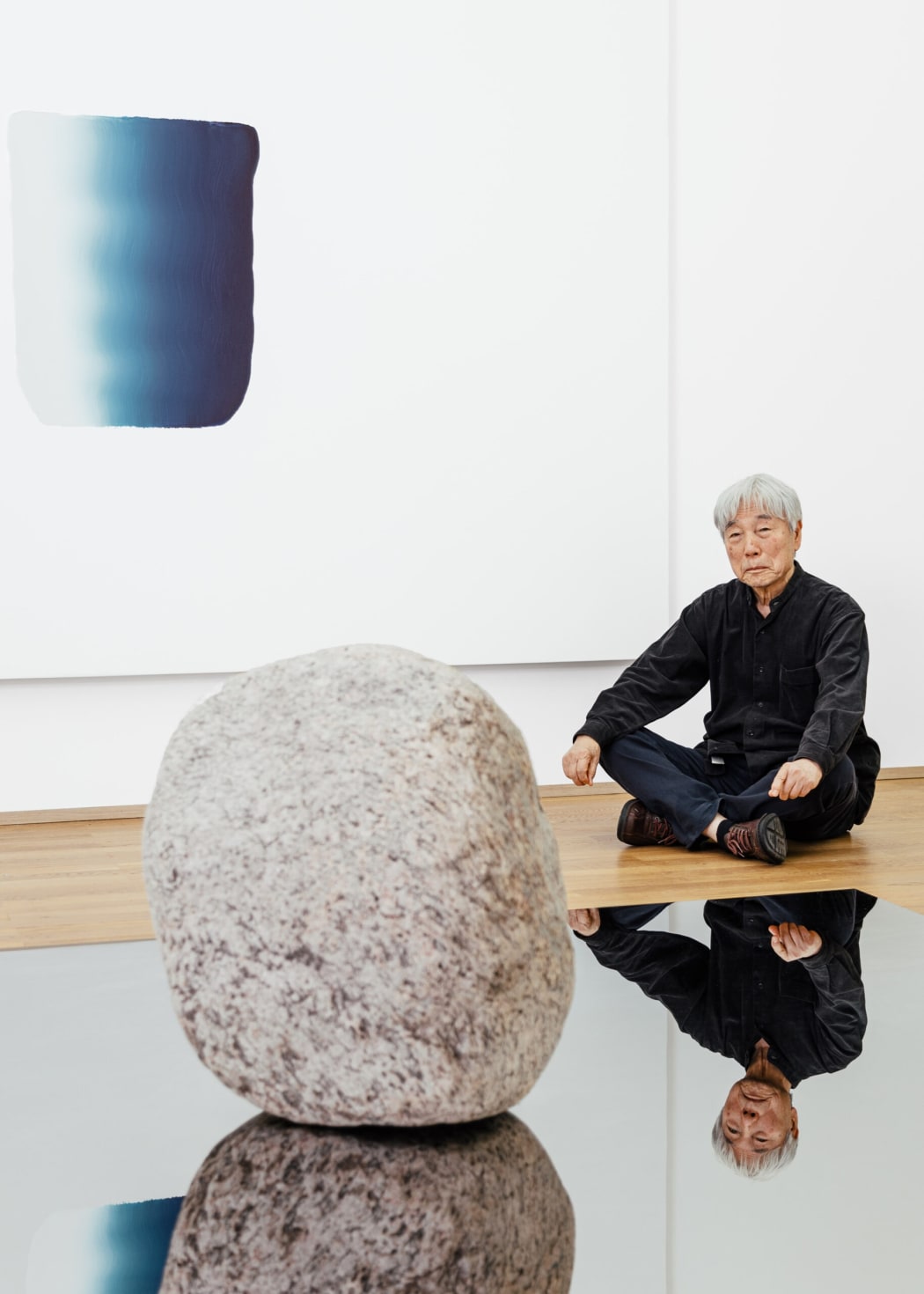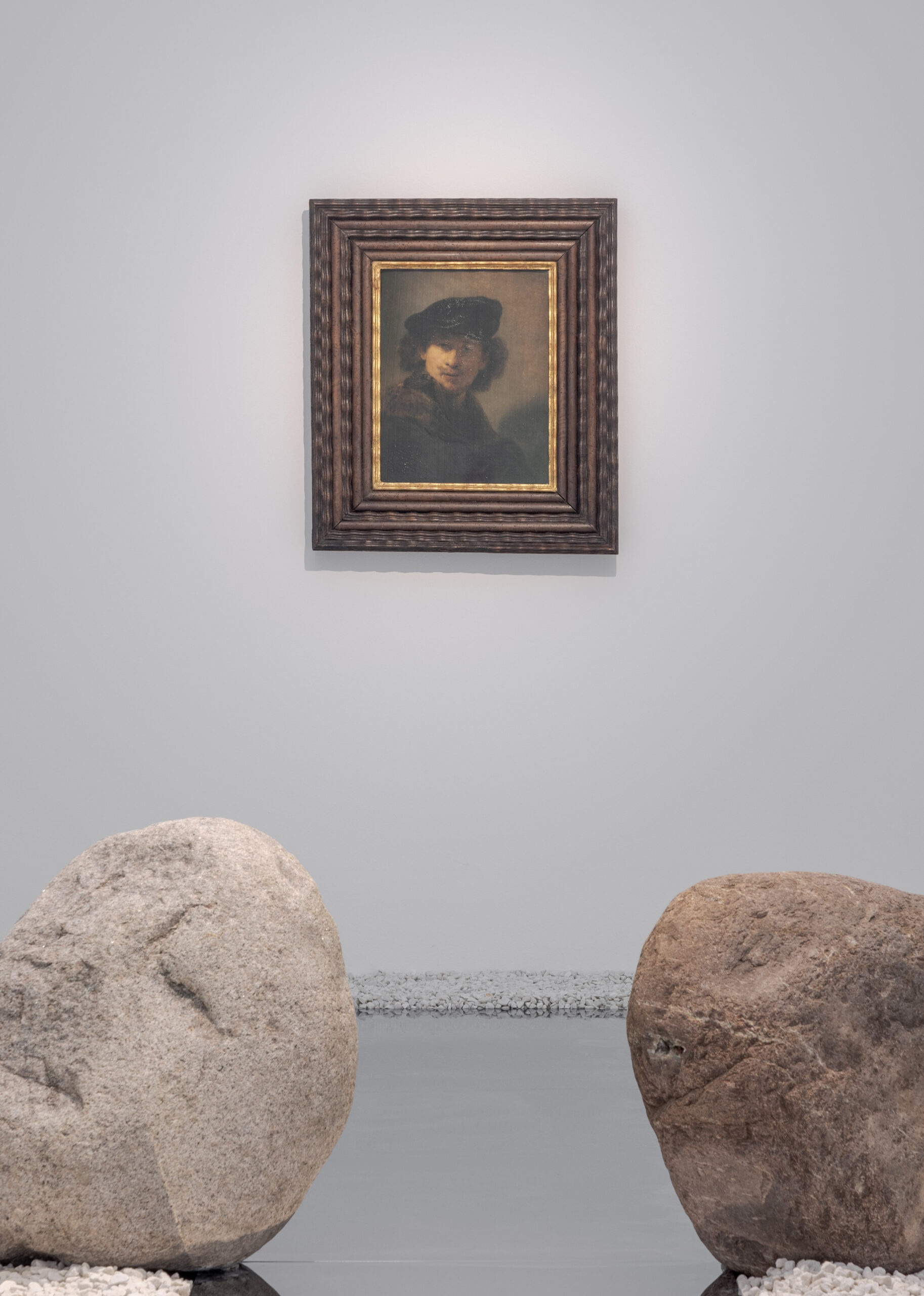
Hamburger Bahnhof – Nationalgalerie der Gegenwart in Berlin hosted the first major retrospective of Korean artist Lee Ufan in Germany. A central figure in Japan’s Mono-hamovement and Korea’s Dansaekhwa painting, Lee presented around 50 works spanning over five decades of his career.
A standout feature of the exhibition was the dialogue between Lee Ufan’s installation Relatum – The Mirror Road(2016/2023) and Rembrandt’s renowned Self-Portrait with Velvet Beret (1634), displayed at Hamburger Bahnhof for the first time. The pairing of these two works created a poetic and contemplative conversation between East and West, offering a new perspective on the legacy of European masters and the philosophical depth of East Asian minimalism.
The installation had a powerful impact on the atmosphere of the exhibition space, creating a unique experience where past and present, tradition and contemporaneity, East and West coexisted in harmony. For many, including the writer of this piece, the dialogue between the two artists felt deeply immersive and emotionally resonant.
Lee Ufan’s Artistic Journey
Born in 1936, Lee Ufan is currently based in Kamakura, Japan. His philosophical writings and conceptual approach significantly influenced the Mono-ha (“School of Things”) group, active in Tokyo between 1968 and 1975. Mono-ha emerged as a key postwar Japanese art movement, combining natural and industrial materials in a manner that foregrounded spatial and material relationships.
Lee’s iconic sculpture series Relatum, begun in 1968, exemplifies this methodology. In parallel, his contributions to Korea’s Dansaekhwa movement include the minimalist painting series From Point (from 1973) and From Line (from 1978), which meditate on repetition, gesture, and the passage of time.
One highlight of the retrospective was the outdoor display of Relatum (1977), shown in Berlin for the first time since 1985, installed in the museum’s sculpture garden.
Through these works, Lee Ufan transcends simple material assemblage, inviting viewers to reflect on the relationship between matter and void, presence and absence. His work speaks quietly but powerfully to the entanglements between nature and humanity, tradition and innovation.
Special Exhibition: Lee Ufan Meets Rembrandt
In tandem with the retrospective, a special presentation titled Lee Ufan Meets Rembrandt took place at the Gemäldegalerie in Berlin. Known for referencing European artistic traditions in his work, Lee engaged in a conceptual and visual dialogue with Rembrandt’s painting, allowing visitors to experience a multilayered conversation between different epochs and cultures.

“Lee Ufan”, Hamburger Bahnhof – Nationalgalerie der Gegenwart, 2023-2024 © Lee Ufan. Courtesy of Studio Lee Ufan / VG Bild-Kunst, Bonn 2023 / Jacopo La Forgia
Opening Night Experience
Attending the opening night of the exhibition was an unforgettable experience. Artists, curators, and art enthusiasts gathered to celebrate Lee’s legacy and exchange insights on his philosophical and material approaches. The unique atmosphere of the space, combined with the profound presence of his work, made the evening a rare opportunity to witness the living legacy of one of East Asia’s most influential contemporary artists.
Lee Ufan’s retrospective in Berlin offered a powerful exploration of his artistic and philosophical journey—bridging East and West, and inviting viewers into a reflective encounter with space, silence, and material essence.
[Korean]
베를린 현대미술의 중심, 함부르크 반호프에서 열린 이우환의 첫 대규모 회고전
2023년 10월 27일부터 2024년 4월 28일까지 베를린의 함부르크 반호프 뮤지엄에서 이우환의 첫 독일 회고전이 열리고 있다. 이우환은 일본의 모노하와 한국의 단색화 운동의 중요한 대표자로, 이번 전시는 그의 50년간의 작품 약 50점을 선보인다.
전시에서 특히 눈길을 끄는 것은 렘브란트의 유명한 "벨벳 베레모를 쓴 자화상"(1634)이 처음으로 함부르크 반호프에 전시된 점이다. 이우환의 설치 작품 "Relatum – The Mirror Road"(2016/2023)와의 대화 형식을 통해 동양과 서양의 예술적 대화가 이루어진다. 이 작품들은 1970년대 일본과 한국의 예술 흐름을 소개하며, 서양 미술의 아이콘에 대한 새로운 시각을 제공한다.
개인적으로 이 설치 작품은 전시 공간의 분위기를 완전히 바꾸는 힘이 있다고 느꼈다. 이우환의 작품과 렘브란트의 자화상이 함께 전시되면서 과거와 현재, 동양과 서양이 공존하는 독특한 예술적 경험을 할 수 있었다.
이우환의 예술적 여정
이우환(1936년생)은 일본 가마쿠라에서 활동 중이며, 그의 철학적 글쓰기는 1968년부터 1975년까지 도쿄에서 활동한 모노하(물체의 학교) 예술가 집단에 큰 영향을 미쳤다. 모노하는 일본 전후 예술에서 중요한 스타일 중 하나로, 자연 재료와 산업 재료를 결합한 작품들을 선보였다. 이우환의 대표적인 조각 시리즈 "Relatum"(1968년부터)은 이러한 예술적 접근을 잘 보여준다.
또한, 단색화 운동에서는 주로 추상적이고 단색의 회화에 집중했는데, 이우환의 "From Point"(1973년부터)와 "From Line"(1978년부터) 시리즈가 이를 대표한다. 이번 전시에서는 1985년 이후 처음으로 베를린에서 선보이는 1977년작 "Relatum" 조각이 박물관 정원에 전시된다.
이우환의 작품을 통해 그는 단순한 재료의 결합을 넘어서, 물질과 공간, 그리고 그 사이의 관계를 깊이 탐구한다. 그의 작품을 보면 자연과 인간, 전통과 현대가 어떻게 서로 얽혀 있는지를 느낄 수 있다. 나는 그의 조각 작품들을 통해 이러한 연결성이 매우 강렬하게 다가왔다.
특별 전시: 이우환과 렘브란트의 만남
전시 기간 동안 베를린의 회화관에서 "Lee Ufan meets Rembrandt"라는 특별 전시가 열린다. 이우환은 자신의 작품에서 종종 유럽의 예술적 뿌리를 언급하며, 렘브란트의 작품과 다층적인 대화를 시도한다. 이 특별 전시를 통해 이우환의 작품이 어떻게 서양 미술과 교류하는지 볼 수 있었다
오프닝 나잇
오프닝 나잇에 직접 참여한 경험은 매우 특별했다. 다양한 예술가와 큐레이터들이 모인 자리에서 이우환의 작품에 대해 깊이 있는 대화를 나눌 수 있었다. 그의 작품을 직접 보며 느낀 감동과, 전시 공간에서의 독특한 분위기는 오프닝 나잇을 더욱 의미 있게 만들어 주었다. 개인적으로, 이우환의 예술 세계를 직접 체험할 수 있어 매우 값진 시간이었고, 그의 작품이 전하는 메시지에 대해 더욱 깊이 이해할 수 있는 기회였다.
이번 전시는 이우환의 예술적 여정과 철학을 깊이 탐구할 수 있는 기회를 제공하며, 동양과 서양 예술의 독특한 조화를 경험하게 한다. 이우환의 작품을 통해 우리는 물질과 공간, 그리고 그 사이의 관계에 대한 새로운 시각을 얻을 수 있다.